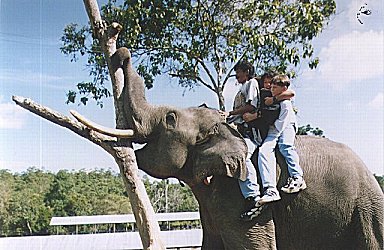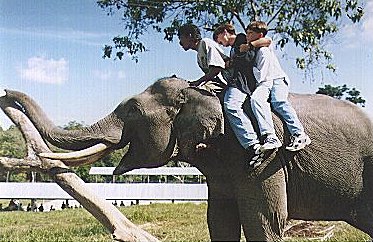Behavior of the Sumatran Elephant
 Our friends in Sumatra, Chris, Patrick and Brad, are on the elephant with the guide.
Our friends in Sumatra, Chris, Patrick and Brad, are on the elephant with the guide.
 Our friends in Sumatra, Chris, Patrick and Brad, are on the elephant with the guide.
Our friends in Sumatra, Chris, Patrick and Brad, are on the elephant with the guide.
By Leann MacDonald and Brad Sivacoe
Sumatran elephants are very social animals. They use infrasonic sounds to communicate with each other. Sumatran elephants roam around the jungle pushing over trees. As they walk they use their roaring and infrasonic sounds to communicate.
Elephants are very protective of their young. When they are being attacked by predators, the older elephants surround their young in the middle of a circle with the bulls on the outside. All of the females are protective of the young. These social pachyderms travel in large groups.
The elephants' strangest behavior involves actions toward their dead. When an elephant dies the others come around, sniffing and moving the bones. They do this as if they are trying to remember the dead elephant. This odd behavior is not yet fully understood.
Elephants are not very friendly zoo animals. There have been cases where they have killed people. Elephants are not easy animals to train. Sometimes elephants fight each other because they want to know who is the strongest and who will have first choice of the female.
Elephants are known to eat a great multitude of food. They eat anything but meat. They eat bananas, palm tree leaves, and almost any other plant. Because elephants have a tremendous appetite, much of Sumatra's jungles and crops are being trampled down.
BY Patick Mathis, Kelly Kaczorowski, Christopher Herlevic
The Sumatran elephant's habitat is in Sumatra, Indonesia. The average male elephant reaches eight feet high and weighs up to six tons. A baby elephant can weigh up to one ton! The males are always larger than the females. They're bulky and gargantuan. They are massive creatures and docile when they are in the untamed world and even when they are domesticated.
 Sumatran elephants have enough strength to knock down a tree. They
can also pick up a log using just their trunk and their tusks. A baby
elephant is called a calf; the females are called cows.
Sumatran elephants have enough strength to knock down a tree. They
can also pick up a log using just their trunk and their tusks. A baby
elephant is called a calf; the females are called cows.
Elephants have a trunk, two tusks, two eyes, two ears and two lumps on their head. They are known to be clever animals. When an elephant is hot, they fan themselves by flapping their ears back and forth. When an elephant herd wants to move they use their ears as a guide. They can hear infrasonic sounds. Their hearing range is very large. Elephants hear some noises that can not be heard by a human ear.
Sumatran elephants are smaller than the African elephants and so these elephants also have smaller ears. Their eyes are always very watery. They have a very poor sight and depend on their well-developed ears and their sense of smell to aid them in times of need. Their trunk is their nose. They also use it like a hand.
Their trunk has over 40,000 muscles that enables them to move it. Their trunk is the most flexible body part that they have. Just below their trunk they have their tusks. Only male Sumatra elephants have tusks. Elephants are hunted for their tusks and people use it for ivory to make decorative structures.
We need to stop the poaching or else the population of elephants will dissapear at a rapid rate. Soon they will become extinct if we do not help protect them.
By Ashley Willis and Karen Kaczorowski
The training of an elephant differs from animal to animal. Depending on the will and spirit of the wild elephant, training can take as little as six months or as long as six years. In order for the trainer to gain respect from the elephant, the trainer must exert his dominance over it through beatings, starvation and deprivation of sleep and water. To restrain the elephant from being destructive and harmful, it is tied to the ground and held there until it is comfortable with the trainer's presence. To reward the Sumatran elephant after its long, hard training, a special song is sung and the elephant is patted on the head by his proud trainers. This ceremony marks the ending of its instruction and the beginning of its new career as a worker.
The elephant is mainly employed with felling trees and carrying them back to camp. Being a live bulldozer, they are able to carry logs weighing as much as six tons with dignity and grace. Sometimes an enormous bull elephant is tied to a tree and used to lure other elephants to captivity. Its superiority attracts them to him. Despite the elephant's size, it can still perform its duties with easy agility. Not only does the pachyderm move logs, but it also transports people to their destinations smoothly and efficiently.
Because elephants are such magnificant, easily trained animals, they are used in circus performances. These shows consist of make-believe hunts, soccer games, and many stunts. In Asia, superstition and tradition has always favored the elephant, where they are believed to have special powers. Many Asians believe that walking under an elephant brings good luck. In the Far East, elephants have always been considered sacred, holy animals. That is why their respecting admirers travel miles to see them. Of late, fate has looked poorly upon the elephants and extinction lurks nearer, but should they die out, they will long be remembered as adroit, graceful, regal animals.
Paul Lane
Date: Wed, 07 Oct 1998 16:26:46 -0500
Dear Pat, I read your site which I found to be very untrue. First of
all, I owned and operated a circus for many years. We used trained
elephants in the circus, and we also used them to put up the circus
tents, and occasionally to push a truck out of the mud. Elephants have
been used to work with for centuries. They are so strong, that pulling a
log that weighs a ton, is like you pulling a little red wagon. The
instrument you are holding is not a "PICK", but an elephant hook. The
elephant's skin is so tough, and so thick, that a sharp pointed object
is all they can feel, and that is to guide them the way the trainer
wants them to go.
Elephants are very intelligent, have personalities of their own,
feelings and can even be compassionate towards their trainers, their
handlers, and other elephants. Much like people, there are some bad
elephants, and some good elephants. I have been around Gorilla's,
Chimpanzee's, Orangutans, and other animals, and I think that elephants
are probably next to humans in intelligence. I love Elephants very much,
and want to see them protected. I want to see them protected from
poachers who make profits from their ivory, and from the great hunters
who kill them for sport, and most of all from civilization. As we
progress in life, we expand our population, and we expand our realms of
civilization. We are devastating the forests where the elephant lives.
Back when the elephants were used in moving teak from the forests, and
they were worked by their beloved mahouts, they thrived in population
and in peace.
I think you should be trying to stop the timber cuttings, and the
expansion of the human populations in Sri Lanka, India, Thailand,
Indonesia, Bangladesh, and all of the African countries where the
elephant is disappearing. After all, they are doing more than
mistreating these majestic, intelligent gentle creatures of the forests,
they are committing elephant genocide!
I think elephants should still be permitted to be exported to the United
States, and exhibited in zoos and circuses, where they are safe, and
where they are taken care of. Many circuses and zoos alike are now
implementing successful breeding programs, and they at least, many
survive in the United States. The people who own them, (and I refer to
MOST of the people) take care of them, house and feed them better than
they eat in the wilds. They are protected with veterinarian health care,
and they live to be in their seventies. I owned one elephant that was
79 when she died. She was retired, and received the best health care,
and plenty of food and attention.
I admire what you are doing, but think there are many other avenues you
could take to SAVE ALL OF THE ELEPHANTS.
John Lewis
Patti
Back to the Virtual Sumatra page
Sumatra
From: john lewis (skora@cdc.net)
To: pweeg@shore.intercom.net
Subject: Abuse?
Thank you, Mr. Lewis for reading our web page and taking the time to respond to us.
pweeg@shore.intercom.net
Return to Global Classroom